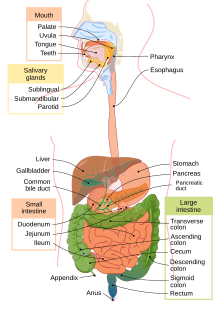
Back دم في البراز Arabic Sang en la femta Catalan Veriuloste Finnish Sang dans les selles French Արյուն կղանքում Armenian เลือดในอุจจาระ Thai 大便見血 ZH-YUE
This article needs more reliable medical references for verification or relies too heavily on primary sources. (April 2017) |  |
| Blood in stool | |
|---|---|
| Other names | Rectal Bleeding |
 | |
| The transition from the upper to lower GI tract is considered to occur at the duodenal-jejunal junction,[1] therefore small intestine is part of both the upper and lower GI tract. Other organs participate in digestion including the liver, gallbladder, and pancreas.[2] Blood entering the upper GI tract travels further, therefore has more exposure to the GI system and can be partially digested into melena before leaving the system.[3] Hematochezia generally occurs lower in the GI tract, and is much closer to its exit, although fast bleeds can occur in the upper system as well.[3] Bleeding of the lower GI tract will typically appear as hematochezia and can vary in degree of seriousness.[4] Slow bleeding from the ascending portion of the colon can result in partial digestion of the blood and the appearance of melena in the stool.[5] | |
| Specialty | Gastroenterology |
| Types | Hematochezia, melena |
Blood in stool or rectal bleeding looks different depending on how early it enters the digestive tract—and thus how much digestive action it has been exposed to—and how much there is. The term can refer either to melena, with a black appearance, typically originating from upper gastrointestinal bleeding; or to hematochezia, with a red color, typically originating from lower gastrointestinal bleeding.[6] Evaluation of the blood found in stool depends on its characteristics, in terms of color, quantity and other features, which can point to its source, however, more serious conditions can present with a mixed picture, or with the form of bleeding that is found in another section of the tract.[6][4] The term "blood in stool" is usually only used to describe visible blood, and not fecal occult blood, which is found only after physical examination and chemical laboratory testing.
In infants, the Apt test can be used to distinguish fetal hemoglobin from maternal blood based on the differences in composition of fetal hemoglobin as compared to the hemoglobin found in adults.[7][8]
- ^ pmhdev. "Lower Gastrointestinal Tract - National Library of Medicine". PubMed Health. Retrieved 2017-12-02.
- ^ pmhdev. "Gastrointestinal Tract - National Library of Medicine". PubMed Health. Retrieved 2017-12-02.
- ^ a b Wilson, I. Dodd (1990). Walker, H. Kenneth; Hall, W. Dallas; Hurst, J. Willis (eds.). Clinical Methods: The History, Physical, and Laboratory Examinations (3rd ed.). Boston: Butterworths. ISBN 978-0409900774. PMID 21250251.
- ^ a b Cotter, Thomas G.; Buckley, Niamh S.; Loftus, Conor G. (2017). "Approach to the Patient With Hematochezia". Mayo Clinic Proceedings. 92 (5): 797–804. doi:10.1016/j.mayocp.2016.12.021. PMID 28473039.
- ^ Cite error: The named reference
:62was invoked but never defined (see the help page). - ^ a b Wilson, Dodd (1990). "85". In Walker, H. Kenneth; Hall, W. Dallas; Hurst, J. Willis (eds.). Clinical Methods: The History, Physical, and Laboratory Examinations. Boston: Butterworths. ISBN 9780409900774.
- ^ "Hemoglobin F". phpa.health.maryland.gov. Retrieved 2017-12-06.
- ^ "Apt-Downey test". www.allinahealth.org. Mar 29, 2016. Retrieved 2017-12-06.
© MMXXIII Rich X Search. We shall prevail. All rights reserved. Rich X Search